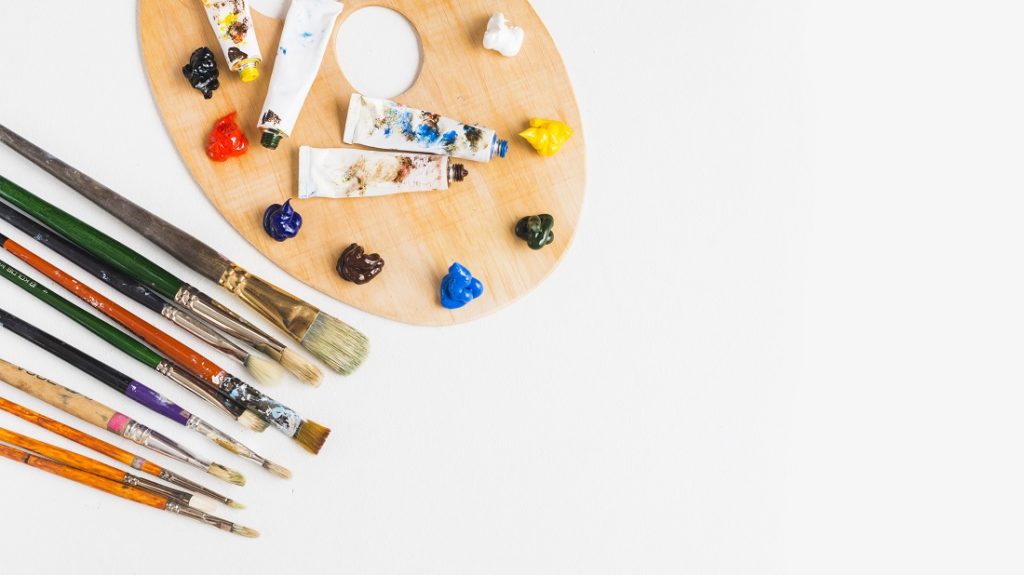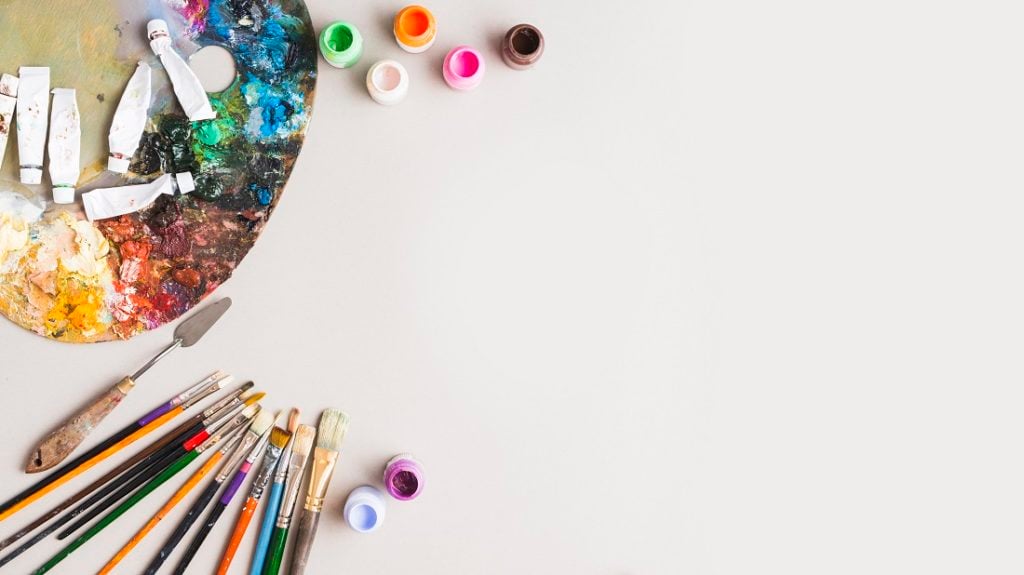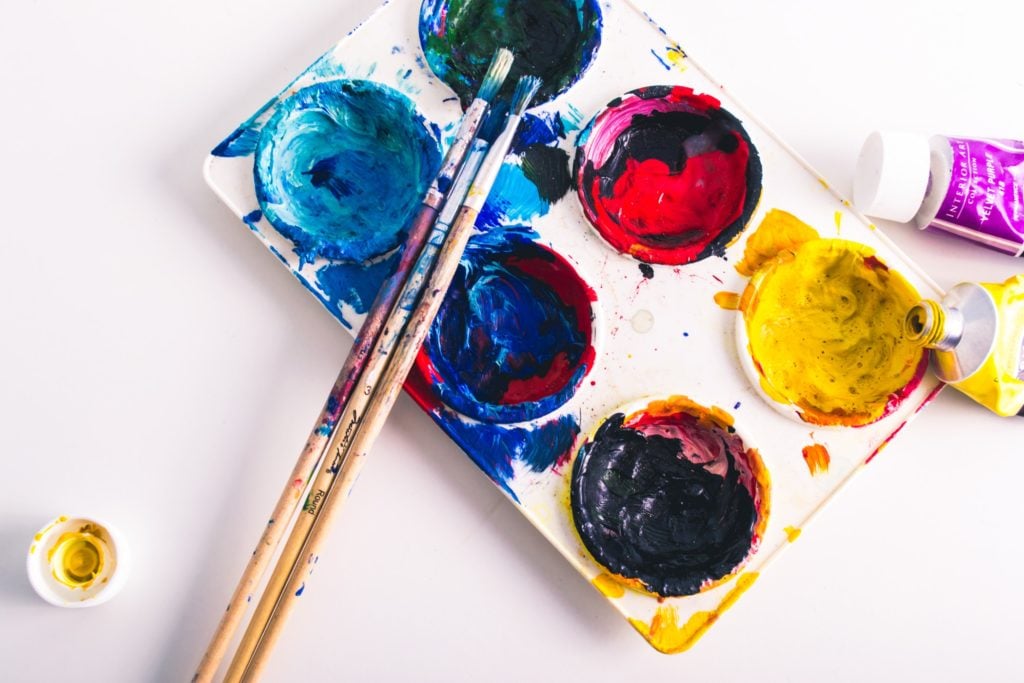Dried paint brushes happen to the best and the most cautious of us.

How many times have you had a burst of creativity, got a great idea in your head, ran into your studio, set up your canvas only to find that all your brushes have dried acrylic paint on them and are now unusable?
It's very normal to forget to wash your brushes after a long and productive painting session. Once, you put the final strokes down on your masterpiece, you're bound to take a step back, appreciate it and call it a night.
Next morning you wake up, go into your studio, only to find your beloved paintbrush has now solidified into one single mass of paint-hardened bristle. Despite your best efforts to untangle, separate or wash the hairs, they are not yielding whatsoever.
We understand how bad it feels. Because of that, we have compiled this guide to walk you through all the separate options you have on how to revive a stiff acrylic-coated paintbrush.
Note: Be forewarned though, that the methods listed below might not be able to help you out as some brushes might just be far too damaged, especially if you've kept them that way for an extended period of time. These methods should only be used as a last resort after all simpler methods have failed.
How to Clean Dried Acrylic Paint Off Brushes

What Kind Of Bristles Are On Your Brush?
First things first, you need to know what kind of bristles are on your brush. They are broadly categorized into two types:-
-
Synthetic Brushes
If your brush has synthetic bristles, then in all likelihood removing hardened acrylic from them is an absolute lost cause. If washing with soap and water aren't working out, then you've pretty much exhausted all your options. It's very hard and almost impossible to get acrylic paint out of synthetic acrylic paint brushes.
This is because synthetic bristles simply do not hold up to the kind of harsh chemicals you need to use to get those clumps of paint coating off. They will probably, break down if they come into contact with harsh chemicals.
You can try out the methods listed below, but we can't guarantee that it'll work. But then go ahead, try it out. After all, you don't have anything to lose, do you?
-
Natural Bristles
If your brush is made out of natural bristles (hog, squirrel, badger bristles, etc.), you'll have a much easier time trying to get the dried-out paint off them.
These bristles are way more suitable for harsh chemical washes. Because of this, we highly recommend buying natural brushes. They may cost a little more, but they make up for that in durability and clean-ability. They'll save you a lot of money in the long run.
So without further ado, let's get down to what solutions you can use to get that dried off paint out of these brushes.

How To Get Dried Acrylic Out Of Brushes
-
Acetone, Nail Polish Remover
Acetone is the primary component in most nail polish removers. You can find it in most medical and cosmetic stores. Thus it would be pretty easy to get your hands on some acetone.
Dipping your paintbrush in an acetone solution will let the acetone penetrate the bristles and get rid of most of the acrylic buildup. The paint simply breaks out of the bristles and dissolves into the solvent.
Tip: Acetone solutions are quite pungent. Hence, they should be kept out of reach of small children and ideally in a room with a lot of ventilation, so that the smell airs out quickly.
-
Rubbing Alcohol, Isopropyl Alcohol
Isopropyl alcohol, commonly found in rubbing alcohol is another excellent choice. It has considerably less odor than acetone and works much in the same way.
The solvent penetrates right into the bristles and dissolves the paint sticking onto them. In fact, most acrylic paint removal kits you find online are basically made out of this ingredient. It's just repackaged and sold under a different brand name.
Hence, if you want to hold on to your hard earned dollars, just get the generic isopropyl alcohol. They work nearly identical to the acetone solution.
Steps On How To Use These Solvents
Once you've gotten a hold of these solvents isopropyl alcohol or acetone, the rest of the process is pretty straightforward.
Step 1
Fill up a glass jar with the solution of your choice.
Step 2
Dip the brush into it up to the level of the ferrule.
Step 3
Let it soak for a few minutes.
Step 4
Take the brush out
Step 5
Rinse with warm soapy water, preferably dish-washing detergent.
Step 6
Repeat process until all the paint clumps are gone.
The process is pretty basic and should be able to get rid of most acrylic buildups, especially if your paintbrush hasn't been in that state for too long.
-
Hand Sanitizing Gel
Your ever faithful hand sanitizing gel now has another use - it can be used to clean the debris off your acrylic paint brushes.
Hand sanitizing gel has pretty much the same chemical makeup as the solvents mentioned above (it uses ethyl alcohol instead.) As a result, it can be used to achieve the same results, in the same way.
In fact, we would prefer this over the others because it's easier and requires no apparatus. All you have to do is squeeze out a bit of it onto your palm and then rub your brush thoroughly and vigorously until all the debris is removed.
Repeat this process a few times, and all the clumps of paint should come out.
It's a manual process, and it might get a little messy, so ensure you have enough water handy to clean your hands and the brush afterward. Use warm soapy water for washing, just like we mentioned before.
Other solvents you can use:
- Ammonia solution,
- Denatured Alcohol or
- Lacquer Thinner
However, using these solutions might be dangerous and pose a safety risk. In our opinion, it just isn't worth it.
Note: In all the processes that we have listed above, remember to ensure that your brush does not stay in prolonged contact with these solutions.
Don't just dip it in the solution and leave it overnight. This can be disastrous for your brush, and all the bristles might get frayed or broken.

What Else Can You Do How to Prevent Dried Paint Brushes
If you've tried out everything we've listed above, (if one of the methods mentioned above didn't work, it's highly unlikely another one will) you can still try out a few manual methods before completely abandoning hope and giving up.
Use An Old Comb And Manually Remove The Clumps
If all fails, get yourself an old comb you no longer use and use it to try to scrape off all the paint gunk of your brush. The finer the teeth on your comb, the more success you'll have with this method.
The first thing you do is wet the brush with a little water and apply a little oil. This will add some strength to the bristles and also, allow the paint clumps to slide off them a little more efficiently, while you run your comb through.
To ensure that you don't break the bristles or pull them out of the ferrule, make sure you grip the bristles and hold them firmly in place at the base near the ferrule. Doing this should prevent any accidental breakage.
Give Your Paintbrush A Trim
If you simply can't get all the paint out, the next best thing is to give the brush a trim. Hey, it's better than simply throwing it into the trash, isn't it?
Besides, you can use that trimmed brush for other painting purposes, for example, stippling. You can even get really creative with your paintings by using differently trimmed acrylic paint brushes. You might just turn a mishap into something marvelous.
Preventive Measures
As the old adage goes, prevention is always better than cure. You'll never have to go through the whole process above if you only had been more careful in the first place.
But it's not all about carelessness. These kinds of things are bound to happen unless you have a set routine or a due process in place.

How to Prevent Dried Acrylic Paint Brushes
-
Always Keep Water Handy
Liquid acrylic is water soluble but not dry acrylic paint is not. When you dip your brushes into the water, the paint breaks off.
It's always a good habit to keep a jar of water handy and somewhere inside your field of vision. So that when your eyes automatically wander there, you'll remember to dip the brushes in there and take it out.
While this is not much of a problem during painting as you'll be using different colors on the same brush, but you might have a few acrylic paint brushes you use once or twice and then keep separately because you don't need them presently. In all probability, you have a separate space for these brushes - the less frequently used ones.
A good idea would be to keep a jar of water alongside these brushes as well. Thus again, as soon as you're done with them, you dip the brushes in the water.
-
Make A Schedule
We get it! Making a schedule is annoying, painful and definitely not an artsy thing to do. But it does have its benefits though.
But if you set aside a specific time out just to clean the brushes, you can rest assured that there will never be any acrylic build up there.
Note: Very often we wash our brushes but not all the way through. As a result, some paint is leftover at the base of the ferrule or the center parts of your brushes. These areas are often overlooked and cause problems later on.
So when you're taking a timeout to wash the acrylic paint brushes, take your time and wash them as thoroughly as you can. It just takes a few seconds more.
What this break will also do, is give you a fresh perspective on your painting. You take a step back, look at your painting, and you might just figure out exactly what it's missing or how you can make it better.
-
Keep Regular Check
If you left your paint on your brushes overnight or only for a few hours, it might dry up, but you won't have any problems cleaning it up with any of the processes mentioned above.
However, the longer the acrylic stays on your paintbrush, the harder it becomes to salvage that paintbrush. If multiple days or weeks have gone by, it can be immensely hard to clean it up.
Thus if you keep a regular check on all your painting supplies, that situation will never come to pass, and your clean acrylic paint brushes will remain clean brushes, dried paint will be a memory of the past.
Final Words
In closing, we'd just like to remind you that the processes we talked about earlier have a relatively high chance of working, but only if the dried paint is not too old.
If the paint is not coming out, rubbing the brush extremely hard will not help your case. On the other hand, it might just break the bristles.
Remember to not let the paintbrush lie in strong chemical solutions for too long; just keep it there for a few minutes.
Don't even keep the bristles immersed in water overnight as this might bend the bristles.
If you've tried everything and it simply isn't working out, then you just have to accept it's time to bite the bullet and get yourself a new set.
Read More on Acrylic Painting
10 Best Paper for Acrylic Paint | Artist and Beginner Grade
10 Best Canvases for Acrylic Painting | Student & Artist Grade
8 Best Palettes For Acrylic Paint & How to Choose What You Need
Learn How To Make An Acrylic Painting Waterproof Right Now
Acrylic Painting Materials That You Really Need In The Studio
13 Best Acrylic Paints for Beginners & Professionals Reviewed
10 Best Acrylic Paint Brushes for Artists & Students Reviewed
Learn How to Make Acrylic Paint in Your Studio
Learn How to Clean Acrylic Paint Brushes Brilliantly
Painting on Paper with Acrylics & 5 Paper-Like Surfaces to Consider
Learn How to Thicken Acrylic Paint Correctly Right Now
Painting Surfaces For Acrylics | Acrylic Prepping 101
Best Cheap Acrylic Paints – Strength and Weakness of Brands Compared
22+ Delicate Beautiful Acrylic Painting Ideas To Try
Learn The Basic Acrylic Painting Techniques for Beginners- Ideas and Projects
20 Oil And Acrylic Painting Ideas For Enthusiastic Beginners
